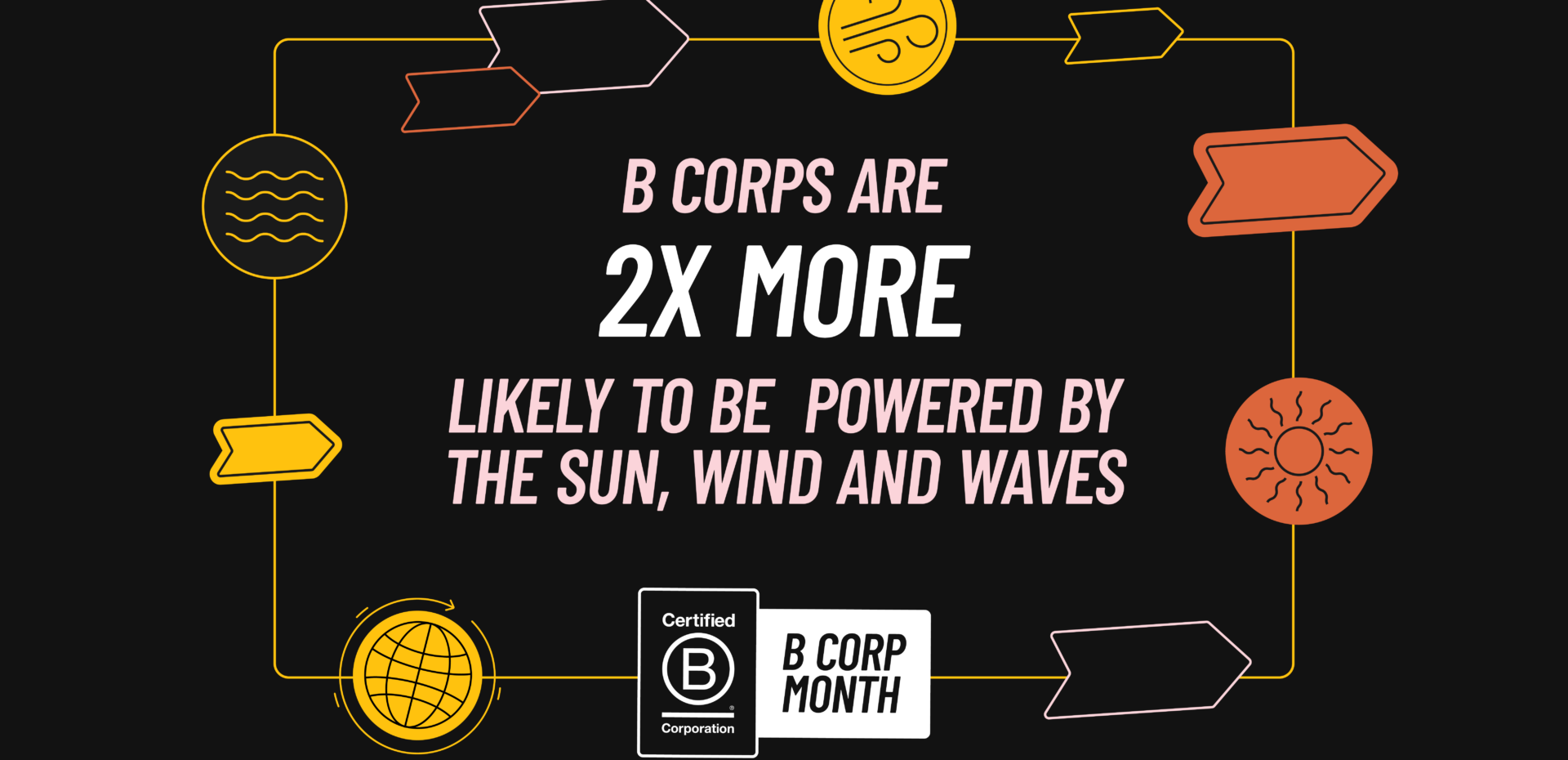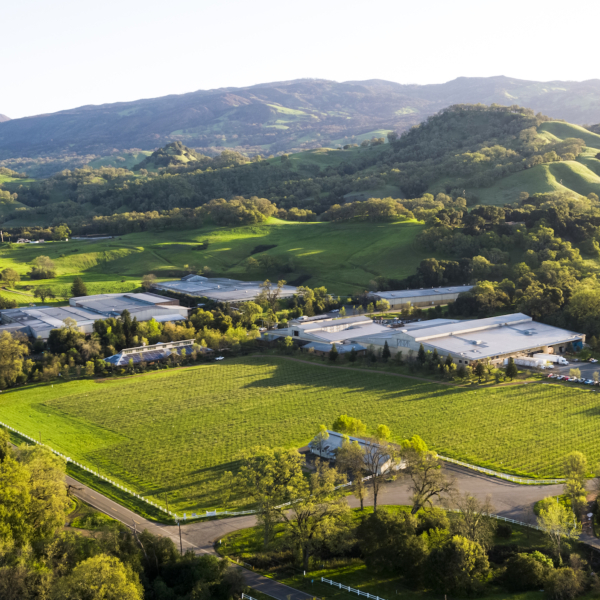Focus on the Planet: How B Corps Transition to Renewable Energy
March 27, 2024
B Corps Use Solar Power, Other Energy Efficiencies as They Pursue Net Zero
“Did you know B Corps are twice as likely to use 100% renewable energy than a non-B Corp?”
For Certified B Corporations concerned with how their business affects people and the planet, transitioning to renewable energy sources can resonate deeply with their values. Measuring and reducing greenhouse gas emissions is also a component of climate action in the proposed new standards for B Corp Certification. As part of B Corp Month this March, we asked several B Corps why they prioritized renewable energy, the steps they took to make the transition, and the results they’ve seen so far.
As a green building consulting firm, it was natural that Catalyst Partners, a B Corp based in Grand Rapids, Michigan, would prioritize renewable energy. Catalyst Partners’ efforts started 15 years ago when the firm purchased a small historic building to renovate into office space. Catalyst Partners set a goal of achieving net zero energy, which means it balances its energy needs with energy produced by renewable sources. The B Corp used an energy model to prioritize energy conservation measures that would enable it to meet that goal. Both the goal and the process were important to Catalyst Partners.
“It is a priority for us to not only demonstrate our commitment to reduce our carbon footprint but also learn from firsthand experience,” said Catalyst Partners Certification Team Lead Shayna Kerkstra.
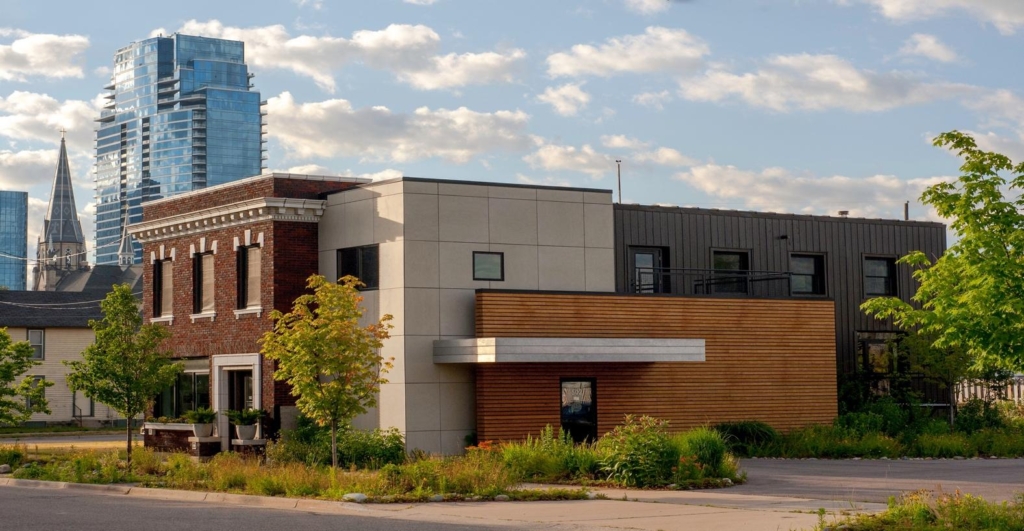
Catalyst Partners renovated a historic building with energy-efficient features including daylighting, natural ventilation, and a geothermal heating and cooling system.
The energy conservation measures employed included daylighting, natural ventilation, building improvements, and a geothermal heating and cooling system. With those measures in place, Catalyst Partners added a 5,000-watt solar system, which has been used for 10 years. With the conservation measures and use of solar photovoltaic panels, Catalyst Partners has seen a 57% reduction in electricity use and energy with 20% on-site renewable energy and 99% building reuse — all amounting to a 60% reduction in utility costs. But Catalyst Partners isn’t stopping there.
“We continue to monitor our energy use and look for opportunities to reach our net zero energy goal,” Kerkstra said. Catalyst Partners is considering repurposing its solar panel system and adding enough 500-watt panels to produce the amount of electricity equal to its annual use. As technologies have improved, so have costs. Kerkstra noted the cost of the 500-watt panels is approximately 30% less than the 250-watt panels the firm originally purchased 10 years ago.

10 Things To Know About B Corps
Certifying as a B Corp is a major milestone and accomplishment — but it is just one part of a company’s ongoing impact improvement journey. This guide features information for people new to or curious about the Certified B Corporation community.
Transition to Renewable Energy Is ‘a Labor of Love’
For Legacy Vacation Resorts, an Orlando-based B Corp, transitioning to renewable energy is part of the company’s commitment to achieving net zero energy and reducing its carbon emissions by 50% by 2030. Legacy Sustainability and Social Purpose Manager Madison Daum described the process as a journey that comes with challenges and rewards.
“The transition process has been a labor of love,” Daum says. “To be transparent, we are still working through details as well as roadblocks. We began our renewable energy journey around two years ago, which includes the surveying, installation, and set up of the panels themselves.”
Legacy worked with Optimus Energy Solutions, a Florida-based general contractor and electrical contractor, to install solar panels at all four of its Florida resorts. Daum says two of the resorts are currently producing solar energy and the team is working to get the other two online. In combination with other energy-saving projects, such as switching to LED lights and installing smart HVAC systems, Daum says the resorts have already seen a significant decrease in energy use. For those interested in pursuing solar, Daum advised companies not to be afraid to advocate for their company — and to remember that smaller steps are also impactful.
“Every local energy company operates and deals with solar differently, so don’t be afraid to ask questions and challenge processes,” Daum says. “While the transition to renewable energy is a big step, there are smaller steps you can take also — investing in energy-efficient appliances is an example.”
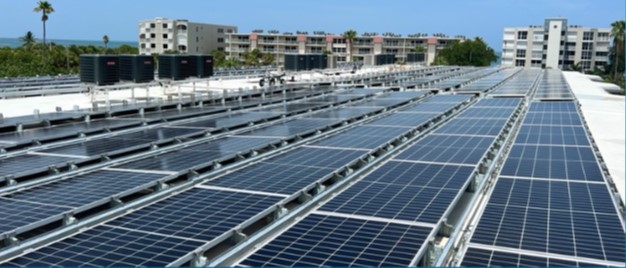
Indian Shores is the first Legacy Vacation Resorts location to debut a completed solar energy project.
A Variety of Upgrades Contribute to Energy Efficiency
Like Catalyst Partners, Southern Energy Management, a solar installer and building performance consultant based out of Raleigh, North Carolina, sought to upgrade its facility to better align with its mission of improving how people make and use energy. Southern Energy Management, which was founded in 2001 and has been a B Corp for 15 years, began assessing and improving its building’s energy use after purchasing it in 2018.
“The 15,393-square-foot facility was built in the 1980s, so there was certainly lots of room for improvement,” said Alyssa Hardbower of Southern Energy Management. “We started with baselining our energy use which led to several efficiency upgrades.”
Upgrades included the installation of high-efficiency heat pumps in several zones in the building, programmable thermostats to optimize conditioning schedules, solar tubes to increase natural light, and updated lighting in the facility’s warehouse. Once Southern Energy Management understood how much energy it needed to offset, the team designed and installed a 52.2 kW solar system to match its energy goals.
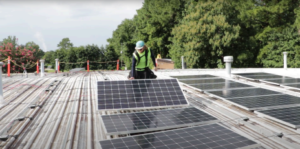
Southern Energy Management added a 52.2 kW solar system at its headquarters in Raleigh, North Carolina.
Since the solar system was installed in 2020, it has generated 206 MWh of solar, offsetting an average of 88% of the facility’s energy use with solar power. Many of the updates, along with the solar installation, also helped Southern Energy Management achieve LEED Silver certification for its building in 2023. Hardbower said Southern Energy Management is working toward expanding its solar system to reach 100% offset of its energy use by the end of the year.
From start to finish, the project took four to five months, with the actual installation only taking about a week. Southern Energy Management Marketing Manager Will Etheridge said that’s fairly typical for a commercial solar project. Projects often require added time to obtain permits from the local inspections department and approval of interconnection requests from the utility.
“Because we deal with solar permitting and inspections every day for our customers, the process for us was smooth and understandable,” Etheridge said. “However, because every utility and local permitting department has different rules and regulations around solar, this can often be a frustrating and confusing part of the process.”
For those considering solar, Etheridge said that Southern Energy Management always recommends looking for a local installer with intimate knowledge of local permitting and utility rules to ensure the process is as smooth and efficient as possible (bonus points if they’re a B Corp!). They also recommend getting multiple quotes and taking the time to understand how solar will work for your organization and its energy goals.

Climate Justice Case Studies
Certified B Corporations are incorporating justice in their climate action with services and products designed for positive social and environmental impact. This set of B Corp climate justice case studies produced by B Lab U.S. & Canada and B Corp Measure Meant studies highlights examples and concepts to inspire other businesses.
B Corp Partnership Incorporates Clean Energy to Reduce Emissions
Other companies have partnered with energy providers that supply renewable energy or offer green energy-related offsets. As part of its effort to eliminate its energy-related emissions footprint, the Canadian B Corp Muskoka Roastery Coffee Co. operates using renewable electricity and green natural gas and fuel from fellow Canadian B Corp Bullfrog Power. Muskoka Roastery Marketing Manager Jordan Neudorf said Bullfrog Power provides electricity and natural gas for the roastery. Muskoka Roastery also purchases offsets from Bullfrog Power to eliminate the balance of its energy-related emissions footprint.
“Since our implementation in 2017, we have avoided 726 tonnes of C02e, which is equivalent to 162 cars taken off the road for one year, 27,527 lightbulbs switched to LEDs, and 353 hectares of forest growing for a year,” Neudorf said.
As part of energy partnerships like Muskoka Roastery’s, companies can continue using their existing utilities. According to its website, Bullfrog Power puts renewable energy into the system to displace any polluting utilities. The offsets support new clean energy sources like wind and solar farms, low-impact hydro projects, and green natural gas producers. Bullfrog Power sources its green natural gas from organic waste at landfills or wastewater treatment plants, and its green fuel comes from repurposed waste streams, such as cooking oils from restaurants.
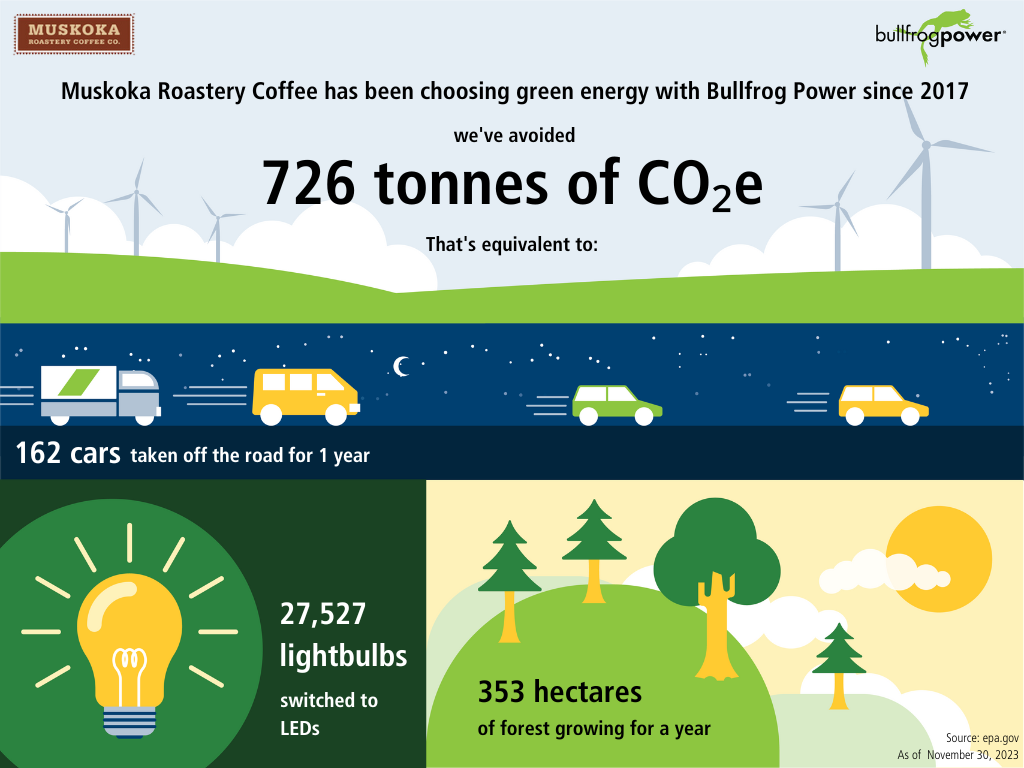
Canadian B Corp Muskoka Roastery Coffee Co. operates using renewable electricity and green natural gas and fuel from fellow Canadian B Corp Bullfrog Power.
Neudorf said the transition was painless for Muskoka Roastery. She said once the company connected with Bullfrog Power, it was simply required to calculate and share its annual outputs, which it was already tracking. Muskoka Roastery is also working on environmental management goals to significantly reduce its carbon intensity — all efforts the company sees as its obligation to nature.
“Our company is based in a place that is, in many ways, symbolic of the best of natural Canada,” Neudorf said. “And our brand is anchored on the idea that these are special places to spend quality time with family and friends, to experience nature. Without the natural spaces — water, forests, untouched land — and the animals that live there, we don’t have a brand. Therefore, we have an obligation to celebrate and protect it.”
Sign Up for our B The Change Newsletter
Read stories on the B Corp Movement and people using business as a force for good. The B The Change Newsletter is sent weekly.
